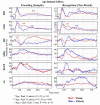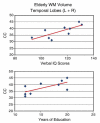Aging: compensation or maturation?
- PMID: 16797187
- PMCID: PMC3777226
- DOI: 10.1016/j.neuroimage.2006.05.005
Aging: compensation or maturation?
Abstract
Neuroimaging studies of healthy aging often reveal differences in neural activation patterns between young and elderly groups for episodic memory tasks, even though there are no differences in behavioral performance. One explanation typically offered is that the elderly compensate for their memory deficiencies through the recruitment of additional prefrontal regions. The present study of healthy aging compared magnetoencephalographic (MEG) time-courses localized to specific cortical regions in two groups of subjects (20-29 years and >or=65 years) during a visual delayed-match-to-sample (DMS) task. MR morphometrics and neuropsychological test results were also examined with the hope of providing insight into the nature of the age-related differences. The behavioral results indicated no differences in performance between young and elderly groups. Although there was a main effect of age on the latency of the initial peak in primary/secondary visual cortex, these longer latencies were not correlated with the performance of elderly on the DMS task. The lateral occipital gyrus (LOG) revealed qualitatively different patterns of activity for the two age groups corroborated by neuropsychological test results. Morphometric results for the young versus elderly groups revealed less white (WM) and gray matter (GM) volumes in the frontal lobes of the elderly. When a group of middle-aged subjects (33-43 years) was included in the morphometric analyses, the middle-aged subjects revealed statistically greater WM volumes in frontal and parietal cortex suggesting immature WM tracts in the young. Perhaps our elderly utilized a different strategy compared to the young due to the different brain maturation levels of these groups.
Figures






References
-
- Aine C, Huang M, Stephen J, Christner R. Multistart algorithms for MEG empirical data analysis reliably characterize locations and time courses of multiple sources. NeuroImage. 2000;12:159–172. - PubMed
-
- Aine CJ, Stephen JM, Christner R, Hudson D, Best E. Task relevance enhances early transient and late slow-wave activity of distributed cortical sources. J. Comput. Neurosci. 2003;15:203–221. - PubMed
-
- Aine C, Adair J, Knoefel J, Hudson D, Qualls C, Kovacevic S, Woodruff C, Cobb W, Padilla D, Lee R, Stephen J. Temporal dynamics of age-related differences in auditory incidental verbal learning. Cogn. Brain Res. 2005;24:1–18. - PubMed
-
- Aizenstein HJ, Clark KA, Butters MA, Cochran J, Stenger VA, Meltzer CC, Reynolds CF, Carter CS. The BOLD hemodynamic response in healthy aging. J. Cogn. Neurosci. 2004;16:786–793. - PubMed
-
- Andreasen NC, Rajarethinam R, Cizadlo T, Arndt S, Swayze VW, II, Flashman LA, O’Leary DS, Ehrhardt JC, Yuh WT. Automatic atlas-based volume estimation of human brain regions from MR images. J. Comput. Assist. Tomogr. 1996;20:98–106. - PubMed
Publication types
MeSH terms
Grants and funding
LinkOut - more resources
Full Text Sources
Other Literature Sources
Medical

